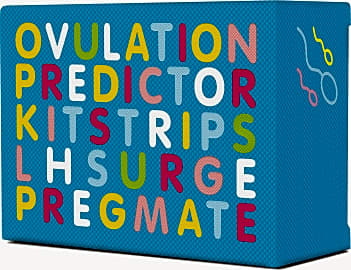The 10 Best Ovulation Tests

This wiki has been updated 43 times since it was first published in May of 2016. When you’re trying to get pregnant, it can be difficult to figure out when your most fertile window is each month. These handy tests can simplify things by helping you determine the best days to conceive. Many models are designed to detect hormonal surges that occur right before ovulation, while others can provide readings by checking for telltale changes in your body’s temperature. When users buy our independently chosen editorial picks, we may earn commissions to help fund the Wiki.
Editor's Notes
June 29, 2020:
In today’s update, we replaced the now-discontinued BLT Smart Fertility Monitor with a somewhat similar model, the Femometer Vinca II, which can be paired with your mobile device to show your results and calculate your daily conception chances by taking into account key symptoms you can input. It also shows your temperature readings on a graph that helps give a snapshot of your ovulation day, fertile window, safe zones, and next predicted period date. It’s great for anyone who wants to monitor their basal body temperature, but who doesn’t want to create charts of their own or write down numbers every day. It’s also a convenient option for anyone who doesn’t relish the idea of urinating on a stick for several days in a row. It comes in a discreet housing that resembles a tube of lipstick, and it’s got a bright, backlit LCD and an adjustable beeping volume. It’s waterproof build makes it a cinch to clean. Today we also added in the Clearblue Monitor, a tried-and-true model from a well-known name in family planning. It typically identifies up to six fertile days each month and alerts you on which days you need to should test your urine. It displays one of three statuses each day: low, high, or peak. This ensures definitive results without your needing to interpret the meaning of lines with various levels of darkness. It’s got a user-friendly touchscreen design and can show your results in calendar or chart modes. It replaces the MediTesti LH, which is no longer manufactured at this time. For a more budget-friendly Clearblue model, look to the Clearblue Digital, which comes with 20 test sticks. While it’s more affordable, it still is able to provide more definitive results than many other sticks that display 1 or 2 bands, or something in between. A smiley face shows up on days you’re most likely to become pregnant.
For another reliable choice, check out the iProvèn FK-127 Kit, which comes with 50 ovulation test strips and 20 pregnancy test sticks. It provides accurate results, and a lot of bang for your buck. Each strip requires just a five-second dip into your urine stream, and they’re each individually packaged, should you want access to one after you’ve left the house for the day. It’s also hard to go wrong with the First Response Value Pack, which is from another well-known name in family planning. It includes 10 dipsticks, seven of which detect fertility and three of which can confirm pregnancy. It’s advertised as being 99% accurate, and each stick is easy to read, thanks to wide, legible lines.
Whether you’re looking to conceive or to avoid pregnancy, be sure to talk with your doctor regarding the best method for you of safe and effective family planning.
Special Honors
Basal Digital Thermometer This handy pink device provides results in just 60 seconds, to a hundredth of a degree in Fahrenheit, to help you determine slight temperature surges that can be a sign of fertility. It features a flexible tip, and its ridges act as a guide for proper placement in your mouth. It beeps when it’s done, and shuts off automatically after 30 seconds to conserve the battery. It comes with a handy ovulation chart and the required CR1225 battery. cvs.com
The Science Behind Ovulation Tests
It helps regulate a woman's menstrual cycle, which is why it can be used to determine when peak ovulation will occur.
Trying to get pregnant can be one of the most frustrating experiences of some couples' lives. Sure, it's easy for many people to get pregnant. So easy, in fact, that it often happens by accident. But that's far from the case for as many as one in every eight couples in America. Even the average couple with totally normal levels of fertility has just a 20-25 percent chance of conceiving each month.
In order to improve their chances of getting pregnant, many women turn to home ovulation tests. These primarily take the form of a strip of paper or small device used to test the levels of luteinizing hormone, or LH, present in a woman's urine. High levels of the hormone typically indicate that a woman will be at her most fertile within the next few days, although results vary from person to person.
LH is produced in the pituitary gland, located beneath the brain. It is produced by both men and women, and serves a range of functions for the body. It helps regulate a woman's menstrual cycle, which is why it can be used to determine when peak ovulation will occur. A spike in LH levels typically occurs a day or two before the optimal time to conceive because it triggers the release of an egg from the ovaries into the uterus.
When trying to conceive, timing is more important than many people may realize. Once an egg is released, if it is not fertilized within 24 hours, a woman's body will naturally dissolve it. In order to capitalize on this window of time, many couples use ovulation tests to govern when they should have sex. Sperm can live for three to five days, so having sex at the time of your LH surge, a few days before an egg is released, may increase your chances of getting the timing right.
Of course, for women who do not want to get pregnant, LH tests can also be used to determine when not to have sex, or when to use protection with a trusted partner. This is often referred to as the rhythm method, and while far from 100 percent effective, it can help couples avoid an unwanted pregnancy. It's important to remember that your body's readiness to conceive has nothing to do with your susceptibility to sexually transmitted diseases, so the rhythm method is only safe for disease-free couples in monogamous relationships.
Additional Ways To Find The Right Moment to Conceive
While ovulation tests are usually accurate with regards to detecting LH levels, they cannot actually predict when ovulation will take place. Depending on the person, actual ovulation may begin within one to two days of a spike, but it also might not. It's also hard to know when to test yourself if you're not keeping close track of your menstrual cycle.
Of course, there is no infallible method for finding the moment when you are most likely to conceive.
For the best results, it's wise to use ovulation tests in combination with a variety of other tools and methods to improve your chances of conceiving. The most important step is to track your menstrual cycle and know where you are in it at all times. This can be difficult for women with abnormal cycles, but there are a variety of tools designed to help, including specially designed calendars and mobile apps for your phone.
Peak fertility usually occurs in the middle of your menstrual cycle. Ovulation tests let you know that the best time to conceive is coming up, but basal thermometers can help you pinpoint the perfect moment even further. These allow you to chart your body temperature to notice patterns that occur in your cycle. For many women, their temperature elevates immediately following ovulation. Tracking your basal temperature at the same time each day can give you a good idea of the perfect moment in your cycle to attempt conception, especially once you've recorded it for a few consecutive months.
The other major indicator of fertility lies within cervical mucus. While it may not have crossed your mind before, there are very specific changes in the amount and consistency of the fluids secreted by a woman's cervix that occur depending on where she is in her menstrual cycle. During peak fertility, the cervix increases production of a clear and stretchy mucus that looks and feels like egg whites. It's designed by the body to provide a protective medium for sperm traveling to the uterus. By taking note of when your body produces this type of mucus and having sex during that time, you can further boost the likelihood that you will conceive a child.
Of course, there is no infallible method for finding the moment when you are most likely to conceive. However, by combining ovulation tests with these other methods, you can certainly increase your chances.
A Note About Infertility
Struggling to get pregnant can be an extremely stressful experience for any couple. There are lots of ways to strategically improve your chances, but, as hard as you might try, the reality is that it is impossible for some couples to conceive without medical intervention, if at all. Infertility is caused by an incredible variety of things, and can rest in the biology of either a male or female partner. It can also be changed or combatted in many ways.
Stress, thyroid problems, alcohol and drug use, and many other factors contribute as well.
Among women, one of the most common causes of infertility is age. The biological clock we often speak of is real, and fertility decreases with age, even long before menopause. Hormonal conditions can also make it difficult to conceive. Tumors, polyps, and cysts in the uterus may also be the culprit, and are often removable. Stress, thyroid problems, alcohol and drug use, and many other factors contribute as well.
Male infertility may be a result of low sperm count or abnormal sperm function. These issues, too, can be caused by a wide variety of health and behavioral issues.
Regardless of what you think the problem may be, if you've been trying to get pregnant for over a year with no success, it's a good idea to talk to a doctor. Many problems are easily resolvable, especially if you move quickly.















